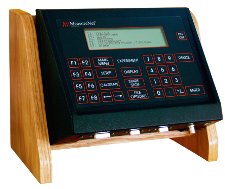The University of Cincinnati uses MeasureNet for Potentiometric Measurements in Sensor Biofouling Research

The MeasureNet MCAN® (Multi-functional Chemical Analysis Network) system consists of up to fifteen measurement workstations networked together and managed by a single MCAN® Controller and PC. Each Workstation has two +/- 2.5v analog input channels and one high-speed serial communication channel. The analog inputs are sampled by a two channel high-resolution 24-bit Sigma-Delta A/D. Sigma-Delta converters are designed for direct connection to sensors with low signal levels. The built-in signal conditioning and noise reduction of Sigma-Delta data converters makes them ideal for the low level noisy signals often found in potentiometric measurements of high impedance sensors like pH, ISE and other electrochemical sensors. The high-speed serial channel is for sensors with digital outputs.
The MCAN® workstation measurements are displayed in real-time on the workstation LCD and/or streamed in real-time to MeasureNet's LabKonnect cloud server for storage. Data collected at the workstations can be stored locally on the system PC and/or in cloud data storage accounts. Cloud data can also be monitored in real-time from any internet connected device - computer, tablet or smart phone, allowing the researcher to follow the progress from virtually anywhere while running experiments for extended time periods. LabKonnect will also alert the researcher via text message if something has gone wrong. The researcher specifies a range; the system notifies team members if measurements go beyond that range. Researchers no longer need to spend valuable time and resources babysitting experiments.
Comparison of the Effects of Biofouling on Voltammetric and Potentiometric Measurements
Kuhlmann, J., Dzugan, L. C. and Heineman, W. R. (2012), Comparison of the Effects of Biofouling on Voltammetric and Potentiometric Measurements. Electroanalysis, 24: 1732–1738. doi: 10.1002/elan.201200194
Abstract
Biofouling of sensors is a common problem when measuring biological samples. The adherence of proteins and biomolecules, called hemostasis, is the first of four steps that lead to biofouling and eventually a foreign body response. This typically occurs within the first hours after the exposure of the biosensor to a biological sample. The purpose of this study was to assess the effect of this initial step of biofouling on cyclic voltammetry and potentiometric measurements. The results show that biofouling occurred rapidly within minutes and strongly affected cyclic voltammetry measurements, while were minimally affected even after 24 hours.